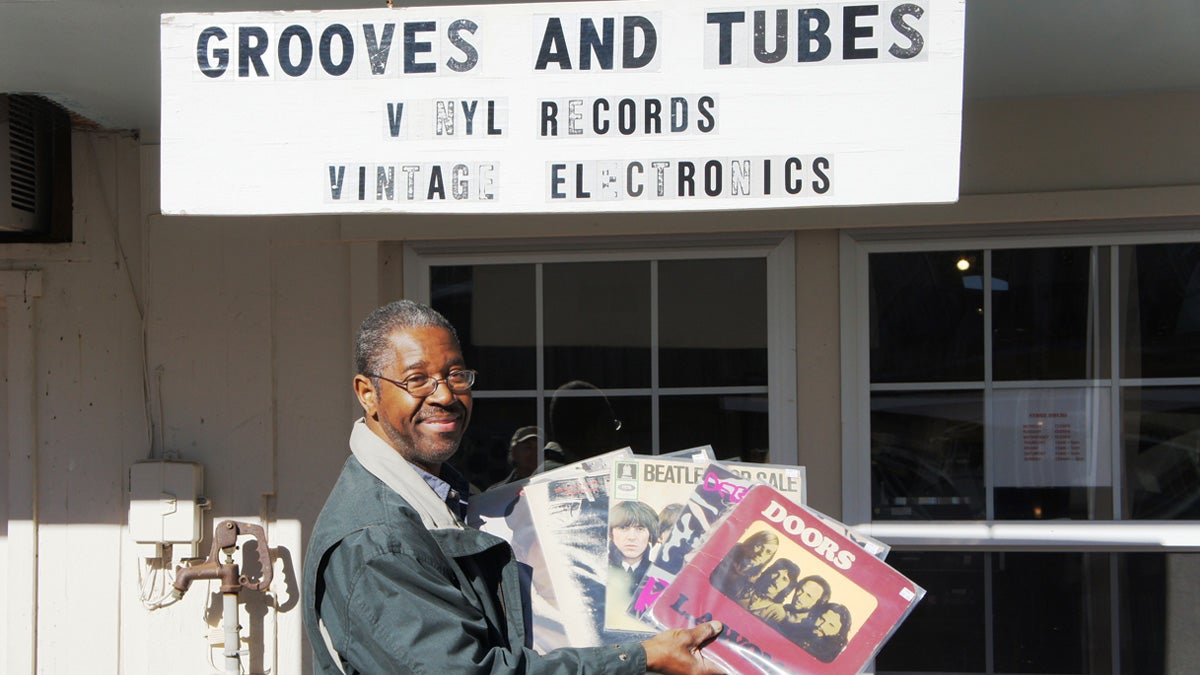Former Delaware Chrysler worker finds new life in classic vinyl

Owner Gerald Young at his Grooves and Tubes shop in Centerville. (Photo by Jane McCuen)
Newspapers are shrinking, flip phones are disappearing, and vinyl records are back.
Left for dead with the advent of CDs in the 1980s, vinyl is making a comeback with a new generation. While records are not going to replace digital music on IPods, smart phones and laptops, demand has been strong enough for major electronics companies to start making old-fashioned turntables again.
Last week Adam Martin was scouring the record bins at the Grooves and Tubes shop in Centerville searching for some rare finds.
“There is a much warmer sound with albums compared to digital downloads,” related Martin, 28, a paralegal who lives in Greenville. “It’s the sound that the artist intended when they recorded their music. I think the way music has been consumed it’s been so instant and immediate that there is now a backlash by young people who really appreciate music. They are focused on buying more and more vinyl. It’s about making music tangible, enjoying the whole experience.”
About a quarter of a century ago vinyl LPs began their decline in popularity. First came the cassette and when CDs took hold, record labels shuttered their LP pressing plants. While there was still a devoted audience of record collectors, the general public flocked to CDs, prized for their portability. Vinyl records were crushed. However, over the past decade CDs have lost significant ground to digital downloads and to the rising use of streaming services such as Pandora and Spotify.
Flying in the face of a 21st century entertainment culture obsessed with small, fast and convenient, vinyl is in vogue once again. About a dozen pressing plants have sprouted up across the country servicing many recording companies that are releasing freshly pressed issues of all types of music. United Pressing in Nashville has been running 24 hours a day, six days a week, for the past two years.
Today, the demand is so great that vinyl orders can take several months to ship. As for the actual music artists, there is a spate of indie bands whose young members think it’s cool to be able to say they’re “on vinyl.”
Indie stores
Vinyl retailers are thriving as well. Hearkening back to the 1960s and ’70s, it’s the indie stores– the mom-and-pop shops– that still make up the backbone of vinyl sellers. Gerald Young is the owner of Grooves and Tubes. You want it, Young either has it or will track the record down. The Beatles, Rolling Stones, Bruce Springsteen, Neil Young, Led Zeppelin, jazz, the blues, some classical music, the 1940s Big Bands and show tunes– all music on used LPs, tucked into their original jackets.
An electrical engineer at the former Chrysler plant in Newark, Young took an early buy-out in 2008 and pondered what he could do to keep himself busy. Six months later he opened the record shop. Young estimates his collection of vinyl at his home in Chadds Ford, Pa. at about 1,000. At Grooves and Tubes albums are stacked floor to ceiling. The inventory is upwards of 2,000 albums.
“I always dabbled in (music) electronics and collecting records so I decided to give the shop a try,” said Young. “It took awhile for the business to gain traction, but then it took off. Our biggest sellers are classic rock from the ’60s, 70s and 80s, then jazz, R &B and soul. This year has been our best ever in sales.”
A bright spot in music sales
Vinyl’s comeback is one of the few bright spots in music sales. Total sales in physical formats like CDs (as opposed to downloads and streaming) plummeted to $898 million in the first half of this year, down 14 percent compared with the first half of 2013 according to the Recording Industry Association of America. While vinyl records account for only 16 percent of that category, their sales shot up 43 percent to $146 million in that same period. Sales of vinyl LPs have grown each year since 2006. Unit sales in 2013 reached 6.1 million, the highest level since 1991, according to Nielsen Co.’s SoundScan.
Amazon.com reports that its vinyl sales have soared 745 percent since 2008. National retail chains like Best Buy, Urban Outfitters and even Whole Foods now carry vinyl in some of their stores across the country. The resurgence is being fueled by hipster newcomers and nostalgic fans returning to the fold.
Young, 60, has never lost faith in vinyl records, or their accompanying turntables and stereo systems and accessories, including cleaning items and protective sleeves that he sells at his shop. When he first started the business, Young was regularly on the hunt at flea markets or digging through garages. With his business well established, he now acquires a majority of the inventory from people who bring their cache of records to his shop, often due to downsizing. Groove and Tubes’ records range in price from $5 to $35 for vintage albums, plus there are dollar bins where gems from long ago regularly turn up.
A part-time guitar teacher, Doug O’Donnell stops by the shop a couple of times a week.
“Over the last couple of years I’ve become a bit obsessive, bought hundreds of records” said O’Donnell, 37, of Coatesville, Pa. “I look for off-beat stuff so I never know when something will catch my eye. Even when records seemed to go away, they didn’t. There’s always been a culture of collectors and aficionados who seek them out. Gerald has a wonderful shop. We’re blessed to have it.”
A more natural sound
Young says with albums it’s a more natural sound that is warm and pleasing to the ear.
“There is distortion with anything that is reproduced,” noted Young who has been collecting records since he was 13 years old. “Digital downloads and CDs can produce listening fatigue. With records there is a three dimensional aspect to it. It’s an easier way to listen to music.
“I also think it’s a reflection of society and culture today where you see this interest in the handmade crafts, micro breweries, the artisanal restaurants, the whole foodie culture these days. Records are another aspect people are experiencing today in the digital age. That’s why I think records are having a resurgence.”
A regular customer at Grooves and Tubes, Martin has been collecting albums over the past two years. He has acquired about 180 records, also making purchases through Amazon.com and Sound Stage Direct in Doylestown, Pa. Martin says the appeal is a more visceral sound, and even the occasional pops and surface noise lends itself to the history of the record.
“I think the connection to the music is very much enhanced when you actually physically get up, pick up an album, place it on a turntable and drop the needle on the vinyl,” Martin said. “You have to make the effort, so I think it’s a much more engaging process than launching a music streaming program on your computer.”
When flipping through racks of LPs at Grooves and Tubes Martin often gravitates toward strong album cover imagery that catch his eye. He says that playing the record and exploring the album package at home is a great stress reliever. He studies the artwork, reads the liner notes and lyrics. It was once a favorite pastime that vanished with the smaller-sized CDs.
“It’s really something of a storybook experience,” Martin explained. “By exploring the album in its entirety, you are immersing yourself in what the musicians intended when the record was first released. The iconic art work, all the stories within the story. You can really appreciate the effort that went into producing not only the music, but the whole creative experience of these amazing albums. It’s all fantastic.”
While digital files satisfy the desire for a music lover’s convenience, true audiophiles want a bigger, better sound that vinyl delivers. Young believes the current trend has legs.
“I think the popularity will continue to escalate,” he said. “I don’t believe vinyl is going anywhere.”
Terry Conway is a Delaware Arts and Culture writer. You can view more of his work: www.terryconway.net.
WHYY is your source for fact-based, in-depth journalism and information. As a nonprofit organization, we rely on financial support from readers like you. Please give today.




